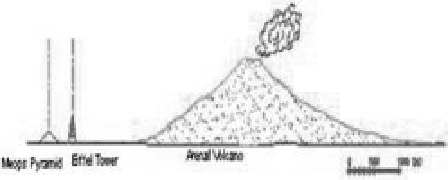Environmental Engineering Reference
In-Depth Information
stability of the cone and foundation of arenal volcano,
costa Rica
G.e. alvarado, s. carboni, M. cordero, e. avilés & M. Valverde
San José, Costa Rica
aBsTRacT: arenal volcano is deforming the basement under ∼20 × 10
3
kPa, and affects it for several
kilometers below the surface and about 5 km around the volcano base. The total settlement below the
present (1968-2009) lava field (0.75 km
2
; 0.6 km
3
) is 2 m o more, but it represent at the moment only 20%
of the consolidation, so its deformation will be continuous for years. The volcano grew up on the top of
weathered volcanic rocks (weak and plastic portion) conditions that are ideal for deforming the basement
(subsidence, folding or faulting) and generate instability on the cone according to structural and volcanic
models. The results of numerical models show that arenal is at an incipient deformation stage by spread-
ing of the basement. The overall effect generates stability at the interior of the volcano and its founda-
tion. The twin edifice (cones c and D) can generate rock slides (cold or hot) as well as debris avalanches
(0.03-0.75 km
3
).
1
inTRoDUcTion
The subsidence due to overloads from infrastruc-
ture has been studied for thousands of years.
however, the deformation produced by a natural
overload on land is not as well known. examples
of this are the subsidence due the emplacement of
lava flow or the growth of a volcanic cone, which
can take from months to millions of years. as an
illustration, a skyscraper transmits approximately
500 kPa to the ground, meanwhile, the load gen-
erated by a volcano varies between 20 × 10
3
kPa
(arenal Volcano) and 78.2 × 10
3
kPa (olimpus
Volcano, Mars).
The arenal volcano, active since 1968 with a
great lava effusion (approximately 0.6 km
3
), suits
well to study the stress' effects and overload capac-
ity (deformation and stability) generated on the
soil underneath it. studies from the past three dec-
ades (1985 to 2000) indicate, through the analysis
of measurements at dry inclinometers that the
foundation where the lava erupted has settled since
1968, are suffering a continuous deformation and
its effects are detected several kilometers away
from the emitter focus. since arenal is a geologi-
cally well known volcano, and its volume and dis-
tribution for the past 7000 years can be calculated,
it helps understand the effects on the substrate or
local basement (foundation), in this case on later-
itic soils, ash soils and lava talus.
in our case, we want to model the growth of
a volcano or cone (edifice or structure) on any
surrounding land, which works as a substrate or
Figure 1. scale comparison of the arenal volcanic
edifice with some great structures.
basement (foundation) of the eruptive edifice. To
accomplish this, we must establish precisely its
geotechnical conditions and characteristics. as
well as understanding when the ladders of a vol-
cano become unstable, are very important for the
correct evaluation of the volcanic hazards.
This paper pretends, through different labora-
tory and field tests, and using different geological
and geotechnical methodologies, the geological
and geotechnical characterization of the arenal
volcano and its foundation, in order to estimate
its deformation and stability conditions, as well as
its geological danger. it also pretends to calibrate
the results from the inclinometers in the volcano
with the results from the geotechnical parameters
from the laboratory tests. Finally, the possible risk
generated by a slide (block and ash flow, rockslide,
debris avalanche), which could affect any infra-
structure or nearby population.
Past studies on the deformation due to the weight
of a volcano and instability-dispersion of a cone
















